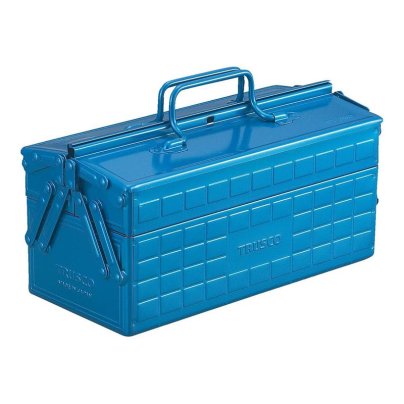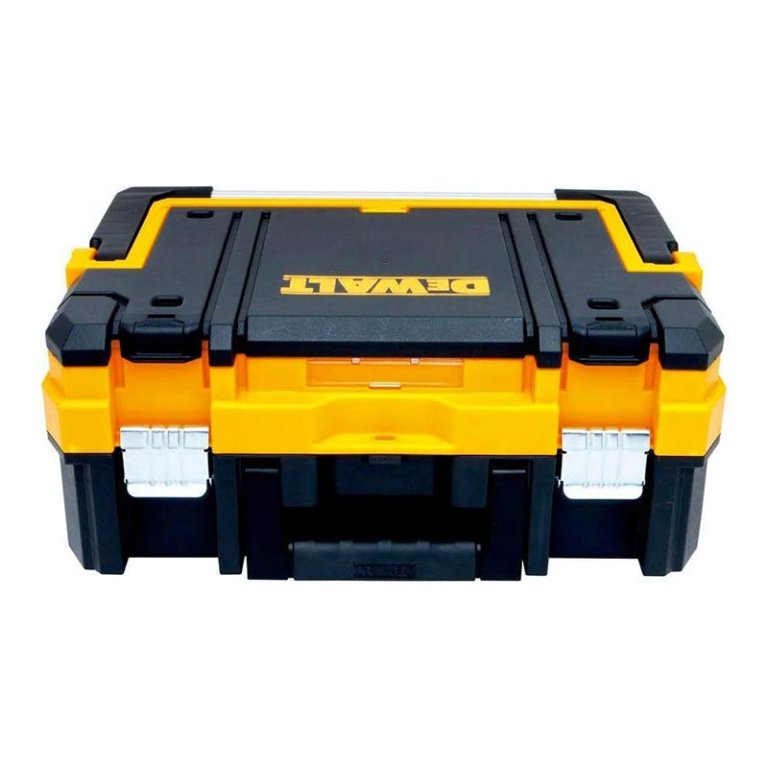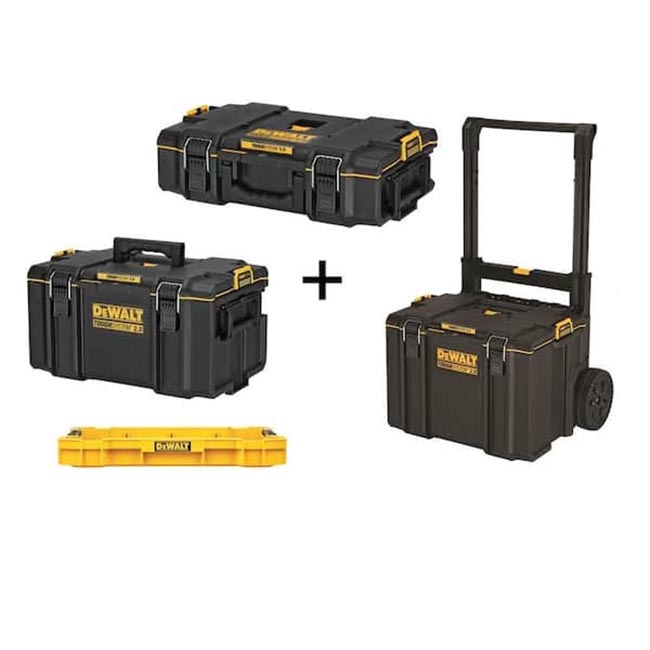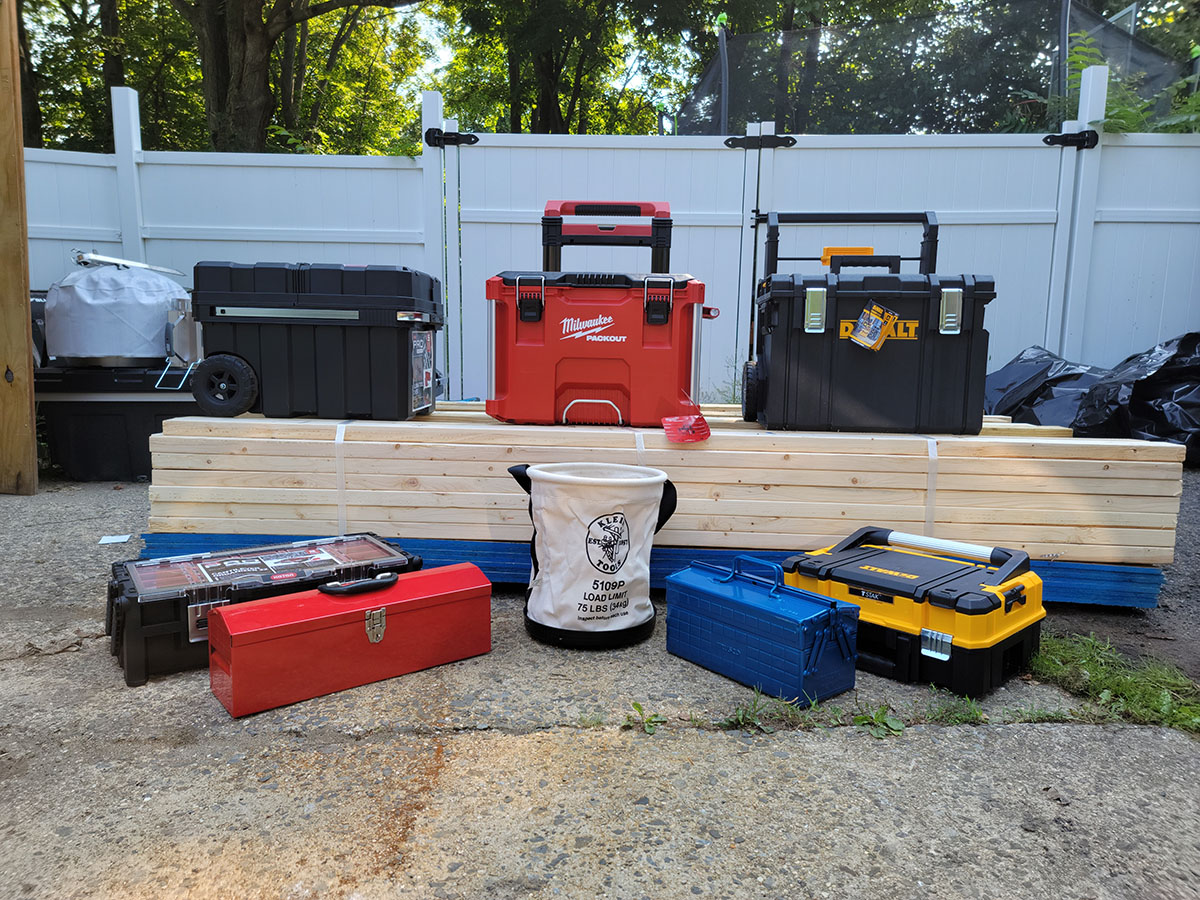
We may earn revenue from the products available on this page and participate in affiliate programs. Learn More ›
What’s the best way to store, organize, and transport your tools? For generations and to this day, the answer has always been a well-made tool box. We researched several dozen tool boxes and chose 10 for testing. We also found a favorite: The Trusco tool box earned top honors in our trials thanks to its two-tiered tool storage system and quality build.
But like tool chests, tool boxes aren’t a one-size-fits-all solution. For this reason, we tested several types, sizes, and designs. Ahead, discover our best tool box shopping tips and find out how the following products earned a spot on our lineup of the best tool boxes.
- BEST OVERALL: Trusco ST-350-B 2-Level Tool Box
↓ Jump to Review - BEST BANG FOR THE BUCK: DeWalt TSTAK Long-Handle Tool Box
↓ Jump to Review - BEST FOR ORGANIZING: Keter Masterloader Rolling Tool Box
↓ Jump to Review - BEST WEATHER-RATED: Milwaukee Packout Large Tool Box
↓ Jump to Review - BEST ROLLING SET: DeWalt ToughSystem Tool Box Set
↓ Jump to Review - BEST PLASTIC: Festool Systainer3 SYS3-Combi M 287
↓ Jump to Review
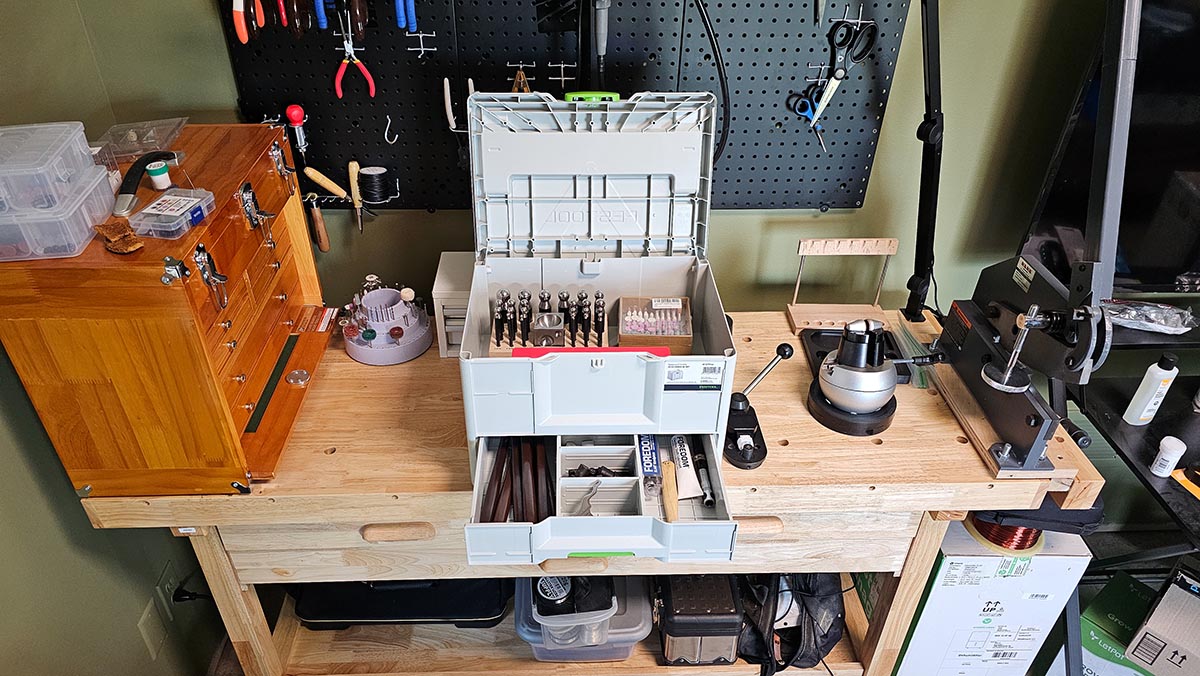

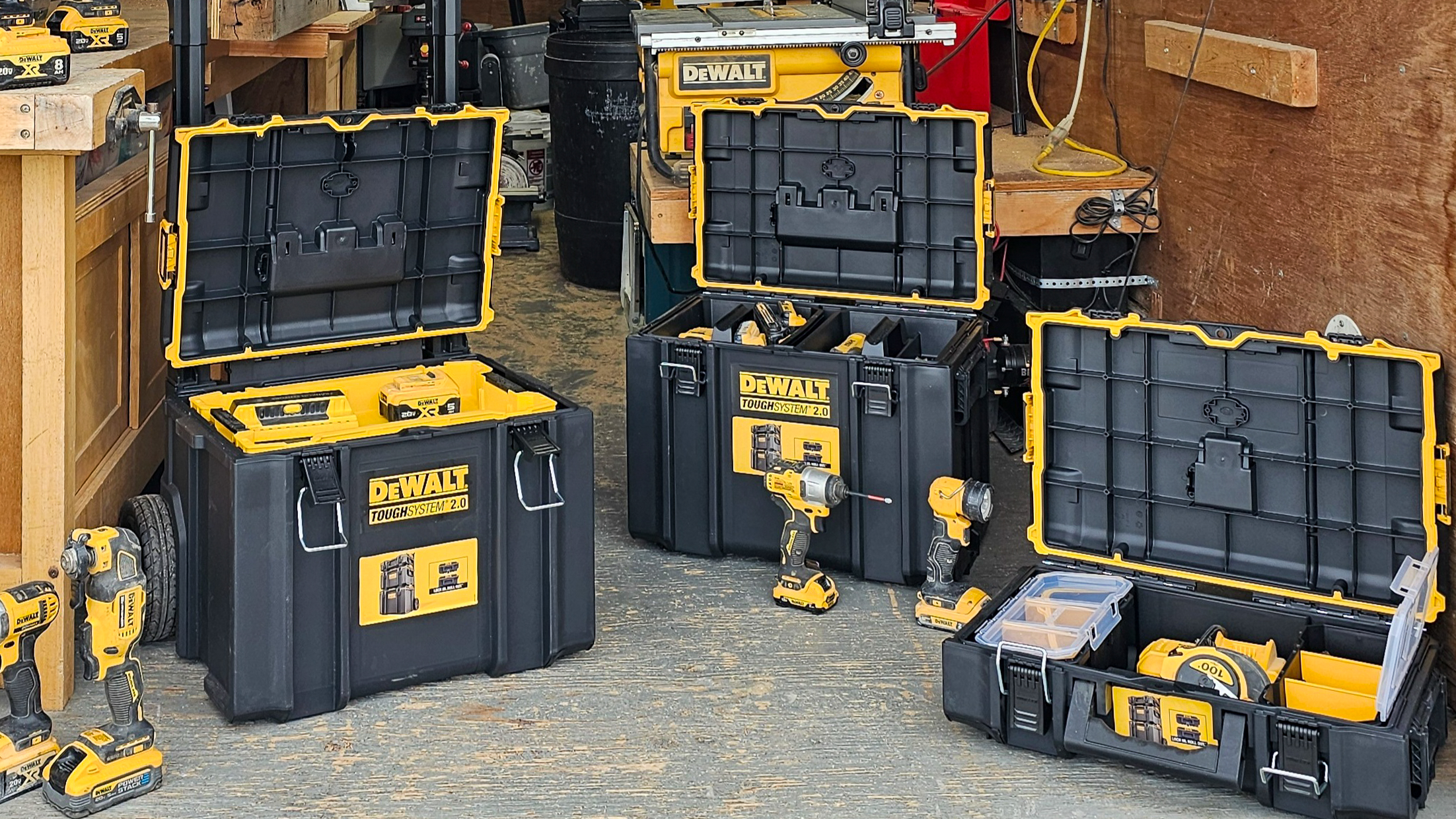
| Testing Stats | |
| Products tested | 10 |
| Time spent testing | 2 to 3 weeks |
| Tests performed | 4 |
| Price range | $60 to $280 |
Our Top Picks
The following tool boxes represent the best models from our hands-on testing. These boxes are designed to store and transport different tools and components, but each one excelled in our trials and earned its spot on this list. One is sure to be the right choice for your tool storage needs.
Best Overall
Trusco ST-350-B 2-Level Tool Box
What We Like
- Excellent handles
- Smooth open-and-close design
- A lot of storage for a smaller box
What We Don’t Like
- No latch
Product Specs
- Material: Metal
- Dimensions: 8.5 inches tall by 13.8 inches wide by 6.3 inches deep
- Transport style: Carry
Our Ratings: Organization 4.5/5; Portability 5/5; Build Quality 5/5; Value 5/5
Finished in spiffy blue enamel, the Trusco two-level tool box features side hinges that allow the top to open in two directions. This reveals a tiered interior storage area that can be customized with reconfigurable metal dividers. The entire box is metal, and the tiered compartments cantilever out of the way smoothly.
It isn’t often that a product surprises us enough to take the top spot during a hands-on review, but we very much liked the Trusco. Compared with other boxes of its size, it’s made with much higher-quality metal, and the fit and finish were spot on. With the box fully loaded, the metal handles were remarkably comfortable to hold. We could fit almost all of our typical hand tools in the box, save for a speed square, staple gun, and one screwdriver. The one issue we found was that it lacks a latch, which we would prefer for transport.
Get the Trusco tool box at Amazon or Kmart.
Best Bang for the Buck
DeWalt TSTAK Long-Handle Tool Box
What We Like
- Works with TSTAK system
- Domed lid allows for a lot of interior storage
- Affordable price
What We Don’t Like
- Top lid isn’t terribly secure
- Not a lot of tool storage in lid
Product Specs
- Material: Plastic with metal latches
- Dimensions: 7.3 inches tall by 17.3 inches wide by 13 inches deep
- Transport style: Tall carrying handle
Our Ratings: Organization 5/5; Portability 4.5/5; Build Quality 4.5/5; Value 4.8/5
The DeWalt TSTAK line of tool organizers includes a variety of tough, tried-and-true options for specialized needs, plus a few everyday tool boxes. This budget-friendly TSTAK model features a segmented upper compartment for small fasteners, bits, and parts, as well as a larger open bottom section for hand tools (or a drill and battery combo). It also has a hole for slipping a padlock through.
There was a lot to like about the TSTAK tool box organizer during testing. In general, we just like the idea of the TSTAK system, so the fact that it has latches and connects to other boxes is appealing. We also like that the lid has a domed shape inside, which means bulkier items that stick up a bit won’t prevent the box from closing. Also, it feels like a steal for the price.
However, there are two things we didn’t like: The plastic lid that holds parts and bits in place isn’t very secure, and there isn’t much storage underneath it for hand tools. Everything goes in the main compartment, which means tools can easily become jumbled.
Get the DeWalt TSTAK tool box at Amazon, Walmart, Grainger, Acme Tools, or Zoro.
Best for Organizing
Keter Masterloader Rolling Tool Box
What We Like
- Easy single-handed opening
- Separate hand tool and parts storage
- Slide-open compartment allows lots of access
What We Don’t Like
- Low-quality telescoping handle
Product Specs
- Material: Plastic resin
- Dimensions: 16.3 inches tall by 24.3 inches wide by 14.9 inches deep
- Transport style: Wheels with telescoping handle
Our Ratings: Organization 5/5; Portability 4.8/5; Build Quality 4.5/5; Value 4.8/5
Keep hefty tools organized while trucking them from project to project with the Keter Masterloader rolling tool box. This heavy-duty resin tool box provides up to 66 pounds of tool-hauling capacity, allowing for the transportation of hand tools, power tools, and hardware. The polypropylene resin is weather-resistant to protect tools from the elements.
The Masterloader features a telescoping handle and two 7-inch heavy-duty wheels for easy pulling. The two top storage boxes slide out of the way, providing access to the tools below. One of those wings has a clear plastic lid and plenty of storage for tools or odds and ends such as screws and nails. The Masterloader also features a top-mounted latch for securing tools, though it doesn’t lock.
We found the Masterloader very easy to open with one hand, and the sliding storage provided all the access we could ask for. We also liked the smaller compartment for hand tools that’s separate from power tools and parts (each of which has its own section). If there’s room for improvement, the telescoping handle is low quality, and the button stuck a few times.
Get the Keter tool box at Amazon.
Best Weather-Rated
Milwaukee Packout Large Tool Box
What We Like
- Rugged and watertight
- Pairs with other Milwaukee Packout stackable tool boxes
- Holds up to 100 pounds
- Single-handed latch operation
What We Don’t Like
- Relatively heavy at 12.1 pounds
Product Specs
- Material: Heavy-duty polymers
- Dimensions: 11.1 inches tall by 22.1 inches wide by 16.2 inches deep
- Transport style: Carry or pair with matching components for rolling
Our Ratings: Organization 5/5; Portability 5/5; Build Quality 4.8/5; Value 4.5/5
The Milwaukee Packout serves as a tough tool box by itself, or it can be paired with any other Milwaukee Packout components for stacking, locking together, or rolling on a Packout rolling base. At 12.1 pounds, it can’t be considered lightweight, but we appreciated that Milwaukee designed it to be a rugged and weathertight tool box.
The box is rated IP65, meaning it will withstand blowing rain, so we tested that claim by setting it in the path of a lawn sprinkler for 30 minutes. We then dried it off and opened it to see if any water had gotten in. We were pleased to find the interior bone-dry.
Although the box features steel latches that hold the top down securely, we were able to open and latch them with one hand. The Milwaukee tool box comes with a 100-pound weight limit and we have no reason to doubt that. We loaded it with heavy tools and sockets and even overloaded it a bit so we had to push the lid to get it to close. The latches (and hinges) held tight. Typically, you probably wouldn’t want to load that much weight in the box, since it’d be challenging to carry, but it’s nice to know it will hold up to the task. Because of their high-quality construction, Packout boxes make great mechanic tool boxes.
Get the Milwaukee tool box at Ace Hardware, The Home Depot, SupplyHouse.com, or Zoro.
Best Rolling Set
DeWalt ToughSystem Tool Box Set
What We Like
- IP65 rated for dust and water resistance
- Durable construction that withstands drops
- Single-handed latching operation
- Backward compatible with older ToughSystem components
What We Don’t Like
- When stacked, lid on upper box bumps handle and won’t stay open
Product Specs
- Material: Plastic
- Dimensions: 60.6 inches tall by 19.9 inches wide by 23.8 inches deep (stacked)
- Transport style: Carry (individually) or roll
Our Ratings: Organization 5/5; Portability 5/5; Build Quality 4.8/5; Value 4/5
When you have a lot of tools to store and tote, DeWalt’s ToughSystem 2.0 is an excellent solution. ToughSystem components come in a variety of sizes, but they’re all designed to connect with other ToughSystem components. The specific set we tested contains a 22-inch small tool box (DWST08165), a 22-inch large tool box (DWST08300), and a mobile storage box (DWST08450).
We loaded a variety of tools in each box—filling them completely—and then attached the large and small box to the rolling mobile base. Auto-connect side latches held the boxes together. Even when we accidentally tipped the tower of boxes over so it fell onto concrete, none of the latches came loose. It was easy to tip and roll the connected boxes, even when they were full, thanks to the large wheels on the mobile base.
This three-piece portable rolling tool box also got a water test, and no water seeped in. Each box comes with removable trays that can be left in or removed to suit individual or garage tool storage needs. The only thing we would change is the telescoping handle. When we had the boxes stacked and we opened the top one to retrieve tools, the lid hit the telescoping handle and wouldn’t stay open. But, that’s a minor issue for ToughSystem components that are built to last and designed for versatile tool box storage needs.
Get the DeWalt ToughSystem tool box (set of 3) at The Home Depot.
Best Plastic
Festool Systainer3 SYS3-Combi M 287
What We Like
- High-quality plastic construction
- Compatible with other Festool Systainer components
- Versatile drawer and open-top design
What We Don’t Like
- Bulky upper latch
Product Specs
- Material: Plastic
- Dimensions: 11 inches tall by 15.6 inches wide by 11.7 inches deep
- Transport style: Carry or combine with matching components to roll
Our Ratings: Organization 4.5/5; Portability 4.5/5; Build Quality 4.8/5; Value 4/5
This rugged tool box is so nice, it’s almost a shame to call it plastic. From German manufacturer Festool comes the Systainer3 SYS3-Combi tool box that features a pull-out drawer at the bottom and a lid that opens in traditional tool box style to reveal a large upper-storage space.
The SYS3 is a new Festool release, but it connects with all other Systainer components. This means you can stack it, lock it, roll it (with a compatible base), or carry it just as it is.
We tested it as a single-carry tool box and found it perfect for storing several small tools and accessories in the bottom drawer and larger items in the upper box. The drawer self-latches in the closed position to keep the contents from spilling out during transportation, but we found it easy to open by pushing upward on the latch.
The top handle is large and fits nicely in hand—it also folds flat against the top of the tool box for stacking or if you want to use the top as a level surface for setting other items. The only thing we didn’t care for was the rotating latch on the top that secures the upper storage area. It seemed bulky, and we would have preferred a one-hand latch. All said, though, the SYS3 is an excellent addition to the Festool line of Systainers.
Get the Festool tool box at ToolNation or Acme Tools.
Jump to Our Top Picks
How We Tested the Best Tool Boxes
We selected the tool boxes we wanted to test using several criteria, including brand. While manufacturers such as DeWalt and Milwaukee are highly respected in the tool and tool storage industries, we also took a careful look at smaller brands that manufacture high-quality tool boxes. Customer satisfaction figured prominently in the models we chose to test as well.
Our hands-on tests were straightforward. We loaded the tool boxes with the types of tools they were designed to hold, and then we carried them or rolled them around if they came with wheels. We examined their build quality and assessed whether their designs were well suited to tool and component storage.
Next, we awarded points based on a rubric. The better a tool box performed on a test or assessment, the more points it received. After testing, we averaged the points to determine our best overall pick and to appropriately categorize the remaining tool boxes.
What to Consider When Choosing a Tool Box
When shopping for the best tool box, keep the following factors and features in mind.
Size and Weight
One of the most important factors to consider when shopping for the best tool box is size. Most DIYers need a tool box large enough to carry the tools they will use most often. Carpenters, electricians, and plumbers have different tool box needs, which means there are many different sizes on the market.
Material
Manufacturers use different types of materials to build tool boxes, usually plastic or metal. Some plastic tool boxes are very durable, and they have many benefits: They don’t dent or rust, and they won’t dull sharp tools such as chisels and saws. Look for a model made from a durable resin.
A metal tool box is an old-school tool storage option that can hold a lot of weight. Stainless steel and aluminum are rust-resistant but expensive, while steel is affordable but can rust when scratched.
Drawers and Dividers
Those looking for lots of organization will want a tool box with drawers and dividers. Many plastic models have removable compartments with snapping lids that help secure smaller bits, pieces, fasteners, and hardware. Some tool boxes have removable trays, which help keep smaller hand tools organized while leaving the bottom open for larger tools such as hammers and saws.
For the ultimate in organization, consider a rolling workstation. These options often have tiered or modular boxes that divide tools into several smaller boxes, with power tool storage underneath.
Wheels
Almost all tools are made from durable steel or other metals, so adding even a few to a tool box can make toting it around difficult. Wheels can make a big difference.
For a mechanic’s tool chest, look for durable ball-bearing-style casters that roll easily and swivel. These casters allow the tool box to roll and maneuver easily.
Rolling workstations often have large plastic resin wheels. These wheels are usually quite durable, and their large size makes it easier to pull them over a ledge or threshold.
Workbench
Rolling tool boxes sometimes include a flat surface on top to use for holding tools or small workpieces. Some even come with hardwood inserts to prevent sharper tools from getting dull.
While these tool boxes aren’t ideal for loading in and out of a truck or transporting to a jobsite, the added work surface can give it a significant advantage over other boxes. For the best of both worlds, choose a rolling box with a work surface and a smaller portable tool box to transport tools.
Locking Mechanism
Most tradespeople know that tools tend to “walk away” from the jobsite. Prevent this from happening by choosing a lockable tool box.
Locking mechanisms come in various shapes and forms. Some have built-in tumblers that lock and unlock with a key, just like an entry lock on a door, while others have a hasp to lock with a padlock. Some plastic tool boxes have holes to slip a lock through to shut the lid.
Waterproofing
While old-school metal boxes work well to store tools, new heavy-duty resin models also protect tools from the elements. This is an important consideration for those whose tool boxes will spend a lot of time in the bed of a truck.
Waterproof tool boxes have seals and sturdy latches that clamp down to prevent water, snow, or moisture from damaging valuable tools inside. This kind of tool box may be particularly attractive for craftspeople such as carvers or woodworkers who have expensive hand tools; the box won’t dull the tools, but it will help prevent them from oxidizing from the weather.
Types of Tool Boxes
Before shopping for a tool box, check out the various types on the market. They range from the classic metal box with a carry handle to full-blown workstations that can organize an entire workshop. This section explains the different types of tool boxes and what DIYers need to know about them.
Hand Carry
The classic metal tool box with a flip-open lid is a hand-carry tool box. Tough and durable, these sturdy boxes are excellent for pros and DIYers alike.
These boxes come in a range of lengths and depths. Old-school carpenters like long, tall boxes to fit their hand saws, while plumbers might prefer a more compact box for pipe wrenches and pump pliers. A DIYer might appreciate something in the middle: long enough to hold a box saw but compact enough not to be too cumbersome.
Rolling
Tool boxes with wheels take the load off—literally. Instead of lugging a heavy tool box around, simply push a rolling unit where it needs to go.
The first type of rolling tool box is the kind in a mechanic’s shop or a building maintenance department. These tool boxes have several drawers, allowing tool storage in separate areas. They often have several thin drawers for wrenches, sockets, and pliers, but they also may have a large, open section with a lock for larger tools such as drills and saws.
The other type of rolling tool box is the rolling workstation. These tool boxes organize tools and parts, but their plastic resin construction makes them lightweight, which often works well for DIYers. These boxes unfold or unstack, revealing all the tools and parts for easy use.
Truck Mounted
Truck-mounted tool boxes help transport tools. These large, lockable, heavy-duty boxes offer plenty of storage, security, and protection from the weather. Manufacturers generally make them from either aluminum (the less expensive option) or stainless steel.
Most truck-mounted tool boxes don’t offer much in the way of tool box organization. They’re cavernous inside, and small hand tools can easily get lost at the bottom. They work best for large power tools.
Bag/Bucket
A bag or bucket is one of the best ways for DIYers to transport their tools. These lightweight tool storage options, typically made of canvas, provide quite a bit of organization with built-in pockets, slots, and loops for specific tools. They often come as stand-alone bags that mimic the shape of a classic wooden tool box with a top handle and open-tray design. Other versions loop around the lid of a bucket.
Heavy-duty classic tool bags with plenty of storage are also available. These bags often have leather bottoms to make them more resistant to the sharp points of screwdrivers and other pointy tools.
FAQs
Even after learning about essential features to look for in a tool box and reviewing the best models available, you might still have some questions. Check out the answers to some frequently asked questions about tool boxes.
Tool boxes are often red so they’re easy to see on a construction site. Workers carrying lumber or plywood can trip over a heavy box if they can’t see it.
If it’s a tool chest, separate your tools into drawers, with ratchets and sockets in one drawer, wrenches in another, screwdrivers in one drawer, and hammers and mallets in another. If you’re using a portable tool box, put longer items in the bottom and use the removable tray to store screwdrivers, chisels, wrenches, utility knives, and other small items.
Clean your tool box with a degreaser or dishwashing detergent, and make sure that the tool box is completely dry before replacing the tools in the box.
A high-quality tool box can last several years, especially if it’s stored in a garage or shed where it’s not subject to harsh sun or inclement weather.
Meet the Tester
Glenda Taylor is a product tester and writer specializing in the construction, remodeling, and real estate industries. She and her husband own a general contracting company, and Taylor is experienced in both residential and commercial building applications. She tests a wide range of power tools as well as other home improvement, household, and lawn-and-garden products.
Additional research provided by Tom Scalisi.
